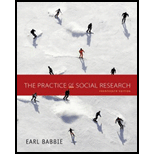
Introduction:
A. The instructor is using a convenience sample, and his/her power over the students is to imply that they must fill out his survey. This is not an appropriate way to gather data for publication.
B. The researcher does not have a therapist-client relationship to protect, so it is legal to comply with the demands of the police. The police are within their rights to collect this information in order to enforce the law.
C. If the author determines that all the other interviews were not falsified, and leaves out the findings of those 25, it would be permissible to publish, as long as the difficulty is mentioned somewhere in the book along with the results.
D. Research cannot be done by deceiving the subjects. This is an ethical violation.
E. The professor may not lie to subjects in order to complete an experiment, and grades should not be falsely lowered to produce the desired effect.
F. Questions written in a leading manner, such as this one, will produce flawed results. This is not acceptable.
G. Since alcohol consumption is dangerous in many ways, the researcher is obligated to publish the findings so that the college may address this trend to reduce the risks faced by students.
H. This study is focused on saving face, but sets up a situation in which people will lose face when the deception is revealed. This is not acceptable as subjects should not be misled.
I. There is a power differential between students and administration, so many students will infer that they must complete the survey. This is not overt deceit, but taking advantage of behavior tendencies related to students’ perceived obligations. As long as no one is punished for not filling out the survey, and no one is rewarded, it is permissible.
J. An official who infiltrates a group should not take part in illegal activity, and should tip off the authorities about planned violence, if they are unable to dissuade the group from committing these crimes.
Explanation of Solution
Answer and explanation:
(This question requires a subjective response, this is an example.)
A. This is not an appropriate way to gather data for publication because the instructor is using a convenience sample, and his/her power over the students to imply that they must fill out this survey. Students cannot be compelled to participate in research because this violates the ethical requirement that participation be voluntary. It also precludes the participants’ right to withdraw from research at any time for any (or no) reason.
B. The police are within their rights to collect this information in order to enforce the law, since the researcher cannot claim therapist-client privacy, it is ethical to comply with the demands of the police.
C. It would be permissible to publish, as long as the difficulty is mentioned somewhere in the book along with the results, and the author could show that all the other interviews were not falsified, nor affected the outcome of the study. Otherwise, the study must be redone.
D. It is an ethical violation to deceive subjects of a study.
E. The professor should not lower grades or berate students under false pretenses just to study their reactions. This is another example of deceiving subjects.
F. Leading questions bias results. This is not acceptable because the researcher is attempting to get people to admit they masturbate.
G. Colleges try to limit dangers faced by students, and pervasive flouting of drinking rules presents clear and present danger, therefore the researcher must publish.
H. This is not acceptable as subjects should not be misled or be made to feel shame or other psychological harm. This study is focused on saving face, but sets up a situation in which people will lose face when the deception is revealed.
I. This is not overt deceit, but taking advantage of behavior tendencies related to students’ perceived obligations because there is a power differential between students and administration, so many students will infer that they must complete the survey. As long as no one is punished for not filling out the survey, and no one is rewarded, it is permissible.
J. A researcher must not be a party to any violent or illegal activity, so he or she should try to talk the group out of the bombing and assassination, or report them to the police. Peaceful demonstrations are not threatening, and it would be okay for the researcher to take part in that.
Want to see more full solutions like this?
Chapter 3 Solutions
The Practice of Social Research (MindTap Course List)
- video "SDG's aren't the same old, same old." What are SDG's? Sustainable Development Goals or "Global Goals" created by the United Nations (UN) https://www.youtube.com/watch?v=v7WUpgPZzpI&t=4sarrow_forwardvideo "SDG's aren't the same old, same old." What are SDG's? Sustainable Development Goals or "Global Goals" created by the United Nations (UN) https://www.youtube.com/watch?v=v7WUpgPZzpI&t=4s Describe at least 3 of the Global Goals mentioned in the video.arrow_forwardWatch the following video about early intervention for children with visual impairments: (its 10 minutes long) http://www.youtube.com/watch?v=6rbHOAtBNew After watching the video, consider the following: How were parents and family members involved in the early interventions offered to their child? Why was this involvement important? What sort of interventions were used? How were these beneficial?arrow_forward
- Simple/ humanized answers: How has the field of education for students with visual impairments (low vision and blindness) evolved? What is the definition of “visual impairment,” how are students identified, and what are the typical causes of visual impairments? Why is early intervention so critical for children with visual impairments, and how can families support children with visual impairments? What are some specific concerns for culturally and/or linguistically diverse children with visual impairments? What kinds of educational responses are needed to address the needs of students with visual impairments?arrow_forwardWould elections have more third-party success if the US had ranked-choice voting nationwide?arrow_forwardAnswer grammararrow_forward
- Would elections have more third-party success if we had ranked-choice voting nationwide?arrow_forwardHow do minor parties influence the U.S. electoral system?arrow_forwardeelancer X English task 1.pdf - Google Driv X kq_A8Yyhcg5Muq83vtY5jmlvjd6ITE/view + Open with Google Docs Task Requirements: Word Count: 300-400 Formatting Style: MLA (for more information click here) *** A minimum of 1 reliable source must be used! Any sources must be properly cited according to the formatting style assigned Many people disagree about the appropriate age to allow children and young adults to use social media. Write an essay that argues your viewpoint about the issue. Develop your claim with reasons and evidence, and form a rebuttal to argue against a counterclaim. Page 1 / 1 Q + 26°C Mcarrow_forward
- DCS cans certification exam answers micaharrow_forwardDescribe a business that has used backcasting or scenarios to assess a situation and then developed a strategy to achieve their goals? what are the obstacles they faced ?arrow_forwardWhy could Backcasting be considered the most useful futuring method? how does the use of modules and simulations relate to futuring? is this method effective?arrow_forward
 Social Psychology (10th Edition)SociologyISBN:9780134641287Author:Elliot Aronson, Timothy D. Wilson, Robin M. Akert, Samuel R. SommersPublisher:Pearson College Div
Social Psychology (10th Edition)SociologyISBN:9780134641287Author:Elliot Aronson, Timothy D. Wilson, Robin M. Akert, Samuel R. SommersPublisher:Pearson College Div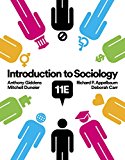 Introduction to Sociology (Eleventh Edition)SociologyISBN:9780393639407Author:Deborah Carr, Anthony Giddens, Mitchell Duneier, Richard P. AppelbaumPublisher:W. W. Norton & Company
Introduction to Sociology (Eleventh Edition)SociologyISBN:9780393639407Author:Deborah Carr, Anthony Giddens, Mitchell Duneier, Richard P. AppelbaumPublisher:W. W. Norton & Company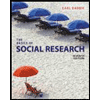 The Basics of Social Research (MindTap Course Lis...SociologyISBN:9781305503076Author:Earl R. BabbiePublisher:Cengage Learning
The Basics of Social Research (MindTap Course Lis...SociologyISBN:9781305503076Author:Earl R. BabbiePublisher:Cengage Learning Criminalistics: An Introduction to Forensic Scien...SociologyISBN:9780134477596Author:Saferstein, RichardPublisher:PEARSON
Criminalistics: An Introduction to Forensic Scien...SociologyISBN:9780134477596Author:Saferstein, RichardPublisher:PEARSON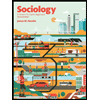 Sociology: A Down-to-Earth Approach (13th Edition)SociologyISBN:9780134205571Author:James M. HenslinPublisher:PEARSON
Sociology: A Down-to-Earth Approach (13th Edition)SociologyISBN:9780134205571Author:James M. HenslinPublisher:PEARSON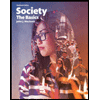 Society: The Basics (14th Edition)SociologyISBN:9780134206325Author:John J. MacionisPublisher:PEARSON
Society: The Basics (14th Edition)SociologyISBN:9780134206325Author:John J. MacionisPublisher:PEARSON





